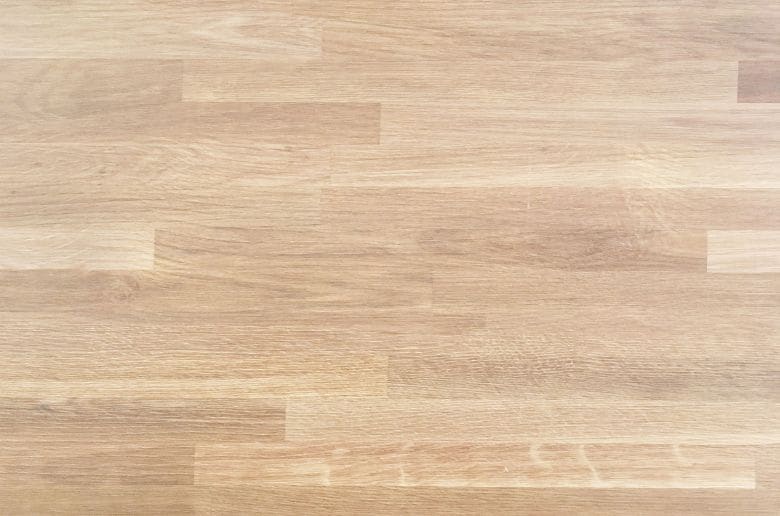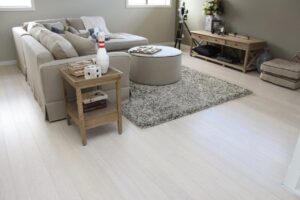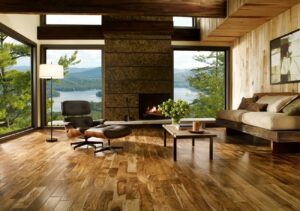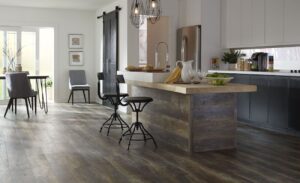The timeless appeal of oak in home design cannot be understated, with its rich heritage and robust presence enhancing interiors for centuries. As we delve into the characteristics of French Oak vs White Oak, we discover a world where each wood type speaks a language of elegance and resilience.
The decision to select the right kind of wood is pivotal, not just for its immediate visual appeal but for the enduring ambiance it creates.
Homeowners and designers alike must weigh a myriad of factors including color, durability, and grain patterns to ensure their flooring choice not only meets the aesthetic demands but also stands the test of time in functionality and style.
French Oak vs White Oak Flooring Comparison
| Feature | French Oak | White Oak |
|---|---|---|
| Color and Tone | Warm tones with grey undertones, uniform honey color | Broad color palette from light blonde to rich browns, more variation |
| Grain Pattern | “Cathedral” type, wavy with pips and burrs | Straighter grain with more variation between planks |
| Durability | More durable and stable, less prone to splitting or cracking | Stiff and strong, suitable for high-quality flooring |
| Plank Size | Long lengths and wide widths due to thin sapwood | Broader planks possible, wider growth rings can dominate in small spaces |
| Geographical Source | Sourced from France, England, Germany | Mainly sourced from North America |
| Species and Origin | Quercus Robur, native to Europe | Quercus Alba, found in Eastern North America |
| Fuming Reaction | Reacts well, resulting in a rich, dark color | Less consistent results with fuming treatment |
Key Differences Between French Oak and White Oak
In the realm of hardwood flooring, the distinction between French Oak and White Oak is significant, not only in appearance but also in performance.
Analyzing Color and Tone Variations
Warmth and ambiance of French Oak
French Oak is renowned for its naturally warm tones, typically exhibiting a pleasing spectrum that includes a honey color with subtle grey undertones.
These hues lend a cozy ambiance to any space, making it highly sought after for settings where a welcoming atmosphere is desired.
The diverse color palette of White Oak
On the other hand, White Oak presents a more varied color range. From light blondes to deep, rich browns, its palette is slightly lighter compared to its French counterpart.
This broader spectrum offers a versatile foundation that can complement various interior designs.
Contrasting Grain Patterns
Distinct ‘cathedral’ grain of French Oak
The grain of French Oak is one of its most distinctive features. Often described as “cathedral” graining, this pattern adds a layer of texture and visual interest, making each plank stand out with its unique appearance.
Straighter grain and plank variation in White Oak
White Oak features a straighter grain with a variation that tends to be subtler than French Oak. This results in a different aesthetic, one that can be more uniform across a space, providing a sleek and modern look.
Durability and Stability in Focus
Resilience of French Oak to environmental changes
Durability is a hallmark of French Oak. It is less likely to react dramatically to changes in temperature and humidity, which means it is less prone to expanding, contracting, splitting, or cracking over time.
The renowned strength of White Oak for flooring
White Oak is celebrated for its strength and stiffness. These characteristics make it an excellent choice for high-traffic areas, promising longevity and enduring appeal as a flooring option.
Plank Size and Availability
The rarity and aesthetics of larger French Oak planks
French Oak planks often come in longer lengths and wider widths due to the thin sapwood characteristic of the species. These dimensions are not only aesthetically pleasing but also contribute to the feeling of luxury and openness in a space.
Availability and practicality of White Oak plank sizes
In contrast, White Oak is typically available in generous widths. However, its growth rings are wider, which can become a dominant feature in smaller rooms, potentially overwhelming the space.
Important considerations for both French and White Oak flooring involve more than just the superficial traits; they encompass a range of attributes from the visual impact to the practicality of installation.
When choosing between these two distinguished types of wood, one must contemplate the interplay between the unique characteristics of each and how they align with the intended design and functional requirements of the space.
Which is Better for Your Flooring Needs?
Selecting the right type of oak for your flooring involves a nuanced understanding of each option’s unique attributes.
Matching Color and Tone to Your Space
The choice between French Oak and White Oak often starts with color. French Oak provides a consistent warmth that can make a large room feel more intimate, while the natural color variations in White Oak can be used to create a tailored aesthetic for any room.
- Deciding on the warmth and cohesiveness of French Oak: If the goal is to create a warm, unified look, the rich and consistent tones of French Oak are preferable.
- Considering the adaptability of White Oak hues: For those looking for versatility, White Oak’s varied hues offer a broad spectrum to match any decor, making it an adaptable choice for different settings.
Assessing Grain Pattern for Visual Impact
The grain pattern contributes significantly to the visual appeal of your flooring.
- The statement-making patterns of French Oak: French Oak’s pronounced grain patterns are ideal for those who wish to make a bold statement with their floors.
- The subtle and uniform patterns of White Oak: For a more understated elegance, the fine and consistent grain of White Oak offers a more uniform look that can blend seamlessly with the existing aesthetics of a space.
Weighing Durability Against Environmental Conditions
Durability is a critical factor, especially in areas with varying environmental conditions.
- The long-term benefits of French Oak’s durability: For spaces exposed to fluctuating conditions, French Oak’s resilience to warping and cracking ensures longevity and sustained beauty.
- The robustness of White Oak in active spaces: In high-traffic areas, the strength of White Oak makes it a pragmatic choice due to its ability to withstand significant wear and tear.
Considering Plank Size in Relation to Room Dimensions
The size of the planks in relation to room size can dramatically affect the room’s visual proportions.
- How French Oak can enhance spaciousness: Larger plank sizes available in French Oak can amplify the sense of spaciousness in a large room, providing an expansive and luxurious feel.
- Using White Oak to complement varying space sizes: White Oak’s diverse plank sizes make it suitable for various room dimensions, allowing for a custom fit that can make small rooms appear larger and large rooms feel more proportioned.
Conclusion
Our comparison illuminates the distinct qualities of French Oak vs White Oak, underlining their suitability for various applications.
We recognize the significance of personal taste and practical considerations in making a final selection. Investing in quality oak flooring is not merely a purchase but a long-term investment towards lasting satisfaction.
Whether one’s preference leans towards the warm ambiance of French Oak or the versatile hues of White Oak, the decision will profoundly influence the aesthetic and functionality of one’s living space.





